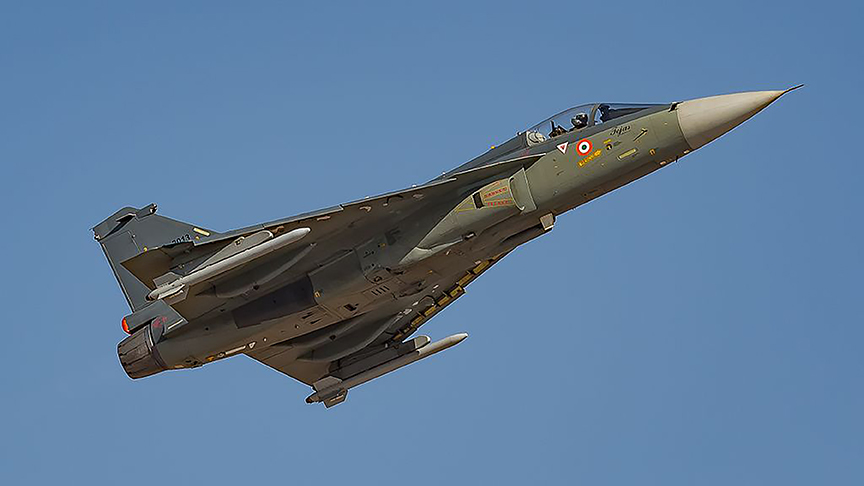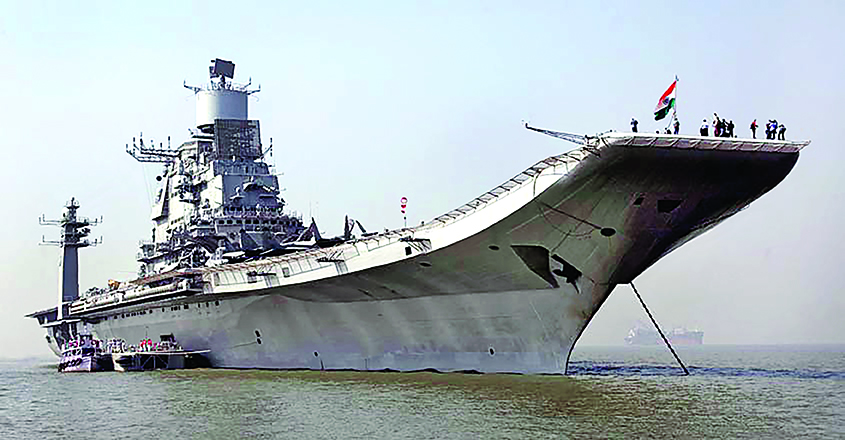Self-reliance in the defence sector can act as a key to decrease India’s dependency on foreign powers, give a boost to the domestic manufacturing sector and reduce the import burden. Public-Private-Partnership in this sector can also show us the way forward
– Dr. Satish Kumar

India’s multirole light fighter, Tejas, designed by Aeronautical Development Agency and Hindustan Aeronautics Limited for the Indian Air Force and Indian Navy
The long driven strategy will make India a great power. China changed itself in three decades. India could do the same. It has the largest pool of talented and skilled youth populations in the world
India is in the election mode. The two biggest electoral issues are related to defence. One is Pulwama attack in which 43 CRPF personnel got martyred in the most gruesome terrorist attacks. Since then, political fever reined the electoral campaign of the respective political parties. The other one is Rafale deal from France, the Opposition’s single point of electoral triade against the PM. This changed the narrative of 2019 Lok Sabha elections. The opposition Congress leader, Rahul Gandhi accused ‘Chowkidar Chor Hai’. The underpinning was that Prime Minister of India is corrupt. The PM declared to his party men and followers to prefix his or her name with ‘Chowkidar’. This has completely changed the landscape of 2019 General Election’s narrative. But the much larger question is how could a country like India which faced two front nuclear enemies, stick to internal debilitating political debate. The army chief and experts of the military wanted Rafael aircraft sooner than later. The combat aircraft strength has gone down drastically. Old aircrafts like MIG-21 and MI-22 are obsolete. They have crashed many times and many young and dynamic air force pilots have lost their lives. India has fought several conflicts and wars in the last 40-50 years since Independence.
The mindset of India needs to be changed. After the humiliating debacle in the 1962 war and the capture of Aksai-Chin area, the first prime minister said in parliament, “not a single blade of grass grows here.’ Responding to Nehru’s words, Mahavir Tyagi a senior Congress leader pointed to his bald head and said, “Nothing grows here, should it be given away to somebody.” At the fag end of his premiership, Dr. Manmohan Singh said, “India does not have a strategic culture.” He was right. But who is responsible for this? If the defence narrative is declared as a stupid electoral gimmick, then what do we expect? After the Pulwama attack, the decisive action taken by India was painted as a pre-planned electoral preparedness by few political parties, then it is bound to be a laggard against our major adversaries. The strategic culture to be evolved needs emotional connections with its people. The Prime Minister has been trying to connect with people. They are finding a rationale from the statements of PM Modi. Perhaps, this could be the first time electoral campaigns are driven by defence underpinnings.

India’s frontline naval vessel INS Vikramaditya
There is no secret to the world that India has turned to be the biggest importer of arms from the foreign market. The condition is so pathetic that overhauling of naval ships is being taken to Russia for rectification. In the early 1990s when the Indian Army considered importing AK-47 automatic rifle it cost 3,500 whereas to manufacture it indigenously would cost 17,000. That itself tells the story of India’s import-driven defence structure. Indian Navy needs to send its EKM 877 Kilo class submarines for medium/long refits and the Indian Air Force its MiG-21 and MiG-29 fighter aircraft for avionics upgrades to Russia, this itself speaks volumes about the lack of Indian defence industrial capabilities. Russia plans to bill the Indian Navy about 125 Rs crores to repair the damaged nuclear submarine INSChakra.
India and China Comparison
There is no dearth of talent in India who could turn it to be the hub of defence. But the mindset was different. The Congress regime remained in an illusion that China would never be a threat to India. Nehru said so many times. Spending on defence was a stupid idea under the Nehru regime. After the humiliating defeat in 1962, weapons became a necessity. But the idea of making our own never appeared and was never discussed. As if India could not do it. There is a background of rocket launching when many of the developed Western countries did not have this. Hyder Ali and his son Tipu Sultan fought against the British in 18th century. They invented the first practical battlefield rocket system in history and used it to telling effect in the Anglo-Carnatic wars of the late eighteen century. Till the end of 20th century, China was the biggest importer of arms, but today it has become the third largest exporter of arms.
Defence Policy and Strategic Perception: India and China
China has completed its makeover with its long term strategy in the defence sector. It is the second largest military force after America. By 2049 it has a clear plan to become the number one military power by the time it celebrates its communist takeover of 100 years. The Indian military faces challenges from the PLA. The focus is on artificial intelligence, cyber robotics and drone technology regimes. The Indian capability in cyber warfare is near zero. The capacity to think big, act strategic, create innovatively and apply the latest technologies, with the aim of becoming an unmatchable military power is still far away from India’s sight. China is channelling huge funds to attain leadership in these and other frontiers areas of science and technology. China, it may be recalled with some wonder, was economically and technologically on par with India in 1979 and forty years later, is the global technology leader. Prof Harsh Pant said, “Indian military leadership has neither bought into the cause to free the nation from the clutches of foreign arms dealers, nor trusted or encouraged the making of homegrown weapons. Since 1947, the Indian armed services have been equipped exclusively with imported weaponry bought off the shelf or licence produced locally.”
India’s Threat Perceptions from Neighbours
A wide range of border disputes exists between India and China and India and Pakistan. China’s economic transformation has given it the capability to emerge as a major military power. China has created unique geopolitical challenges for India. During the British, India had a strategic edge over China. For the first time in its independent history, the emergence of a great military power at its immediate frontiers now appears imminent. China’s threats are visible. The Doklam standoff was a reminder. The Sino-Indian border dispute continues to fester. India-China border dispute is not only the largest territorial dispute in Asia but is also one of the longest-running conflicts in the history of Post-World War II Asian politics. The two nations sharing a 2520-mile-long border are embroiled in a contest for over 47,000 sq mile of Himalayan territory. The China-Pakistan ‘axis’ has always been a source of great consternation for India. This nexus between Islamabad and Beijing has only grown stronger in recent years. China’s footsteps into the Indian Ocean have only added fuel to fire. In the last one decade, China has developed naval facilities in Myanmar, Sri Lanka and Pakistan; and is even planning to build naval infrastructure in Seychelles.
Modi’s Vision of Make in India
PM Modi was aware of India’s limitations in the defence sector. But at the same time, he had imagined the big opportunities for indigenous development of the defence sector. Talented Indians are hired by the West. Why cannot we do it? Indian acceptability to the world market is much more than the Chinese. If India turns to be arms’ producer, then many of the Chinese buyers will shift to India because of India’s credibility and behaviour. This will lead to the booming of jobs in the defence sector. Approximately one lakh jobs could be created in a year. PM Modi while addressing the Global Investment Entrepreneurship Summit in Hyderabad in November 2017 said, ‘I invite each one of you to become a partner in India’s growth story. And once again assure you of our wholehearted support.’ The government released its Defence Production Policy, 2018, a very ambitious plan of making India a great power by 2025. India’s current requirements on defence are catered largely by imports. The opening of the defence sector for private sector participation will help foreign original equipment manufacturers to enter into strategic partnerships with Indian companies and leverage the domestic markets as well as aim at global markets.
Today India is the largest arms importer in the world and spends annually on an average of about $3.6 billion, which is more than the combined imports of both Pakistan and China. India has millions of military personnel, billions of dollars in arms spending and grave threats on its borders, yet the nation doesn’t make its own fighter jets and anti-tank missiles. Last year, defence spending rose 5.5 per cent to almost $64 billion, Prime Minister Narendra Modi deserves credit for a $250 billion military modernisation plan. The PM has to remove the bureaucratic bottleneck. There are two different models which could act as guiding principles for India. The US Defense Advanced Research Projects Agency (DARPA) has a team of only 240 scientists who run all its R&D activities through funds provided to academic institutions and private industry. In Israel, there are wholly state-owned ordnance factories, public-private partnership defence companies and completely private defence companies that undertake both R&D and defence production. It is both an economic necessity as well as a national security imperative to reduce India’s annual average defence import bill and become self-reliant in our defence technologies. This will benefit the country’s economy especially its manufacturing industry. The long driven strategy will make India a great power. China changed itself in three decades. India could do the same. It has the largest pool of talented and skilled youth populations in the world. Modi’s vision of self-reliance in the defence sector will change the face of India forever.
(The writer teaches at MMH College, Ghaziabad)













Comments